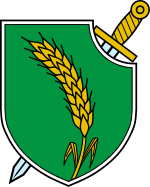Yugoslav People's Movement Југословенски народни покрет Jugoslovenski narodni pokret | |
|---|---|
 | |
| President | Dimitrije Ljotić |
| Vice president | Juraj Korenić |
| Founded | 6 January 1935 |
| Dissolved | 1945 |
| Merger of | Various radical groups[n 1] |
| Headquarters | Belgrade, Yugoslavia |
| Newspaper | Fatherland[3] |
| Student wing | White Eagles (from 1940) |
| Paramilitary wing | Serbian Volunteer Corps[4] |
| Membership | Fewer than 6,000 (1939 est.)[5] |
| Ideology | Yugoslav fascism[n 2] |
| Political position | Far-right |
| Religion | Serbian Orthodox Christianity |
| Colours | Green Yellow White |
| Anthem | "Vojska Smene" |
The Yugoslav National Movement (Serbian: Југословенски народни покрет, Jugoslavenski narodni pokret), also known as the United Militant Labour Organization (Здружена борбена организација рада Združena borbena organizacija rada, or Zbor / Збор[17]), was a Yugoslav fascist movement and organization led by politician Dimitrije Ljotić.[18][19][20][21] Founded in 1935, it received considerable German financial and political assistance during the interwar period and participated in the 1935 and 1938 Yugoslav parliamentary elections, in which it never received more than 1 percent of the popular vote.
Following the Axis invasion and occupation of Yugoslavia in April 1941, the Germans selected several Zbor members to join the Serbian puppet government of Milan Nedić. The Serbian Volunteer Corps (SDK) was established as Zbor's party army. Ljotić had no control over the SDK, which was commanded by Colonel Kosta Mušicki. In late 1944, Ljotić and his followers retreated to Slovenia with the Germans and other collaborationist formations. In March, Ljotić and Chetnik leader Draža Mihailović agreed on a last-ditch alliance against the Yugoslav Partisans. Ljotić's followers were placed under the command of Chetnik commander Miodrag Damjanović. Ljotić was killed in an automobile accident in late April 1945. His followers later fled to Italy alongside the Chetniks. The Western Allies extradited many back to Yugoslavia following the war, where they were summarily executed and buried in mass graves. Those who were not extradited immigrated to western countries and established émigré organizations intended to promote Zbor's political agenda.
- ^ Schreiber, Gerhard; Stegemann, Bernd; Vogel, Detlef (1995). Germany and the Second World War. Clarendon Press. pp. 322–. ISBN 978-0-19-822884-4.
- ^ Kardelj, Edvard (1981). Socialist Thought and Practice. Vol. 1–7. p. 52.
- ^ Отаџбина / Otadžbina
- ^ (1941–1945)
- ^ Marija Vulesica: Handbuch des Antisemitismus: Judenfeindschaft in Geschichte und Gegenwart. Hrsg.: Wolfgang Benz. Walter de Gruyter GmbG & Co. KG, Berlin/Bostin 2012, p. 651. ISBN 978-3-598-24078-2
- ^ Antonio Costa Pinto as ed., Corporatism and Fascism: The Corporatist Wave in Europe. Routledge Studies in Fascism and the Far Right, Taylor & Francis, 2017, p. 30, ISBN 1315388898.
- ^ Frieser, Karl-Heinz; Schmider, Klaus (2017). The Eastern Front 1943-1944: The War in the East and on the Neighbouring Fronts. Germany: Militärgeschichtliches Forschungsamt. p. 1087. ISBN 978-0-19-872346-2.
- ^ Cox, John K. (2002). The History of Serbia. Westport, Connecticut: Greenwood Press. p. 84. ISBN 978-0-313-31290-8.
- ^ Haskin, Jean (2006). Bosnia and Beyond: The "quiet" Revolution that Wouldn't Go Quietly. New York: Algora Publishing. p. 28. ISBN 978-0-87586-428-0.
- ^ Hoare, Marko Attila (2014). The Bosnian Muslims in the Second World War. New York: Oxford University Press. p. 110. ISBN 978-0-19-936531-9.
- ^ Tomasevich, Jozo (1969). "Yugoslavia during the Second World War". In Vucinich, Wayne S. (ed.). Contemporary Yugoslavia: Twenty Years of Socialist Experiment. Berkeley, California: University of California Press. pp. 59–118. ISBN 978-05-200153-6-4.
- ^ a b Rebecca Haynes; Martyn Rady (30 November 2013). In the Shadow of Hitler: Personalities of the Right in Central and Eastern Europe. I.B.Tauris. p. 300. ISBN 978-1-78076-808-3.
- ^ a b Jovan Byford (2008). Denial and Repression of Antisemitism: Post-communist Remembrance of the Serbian Bishop Nikolaj Velimirović. Central European University Press. p. 52. ISBN 978-963-9776-15-9.
- ^
Badie, Bertrand; Berg-Schlosser, Dirk; Morlino, Leonardo, eds. (7 September 2011). International Encyclopedia of Political Science. SAGE Publications (published 2011). ISBN 9781483305394. Retrieved 9 September 2020.
[...] fascist Italy [...] developed a state structure known as the corporate state with the ruling party acting as a mediator between 'corporations' making up the body of the nation. Similar designs were quite popular elsewhere in the 1930s. The most prominent examples were Estado Novo in Portugal (1932-1968) and Brazil (1937-1945), the Austrian Standestaat (1933-1938), and authoritarian experiments in Estonia, Romania, and some other countries of East and East-Central Europe,
- ^ Christian Kurzydlowski (2017). Ideology and Politics Of Dimitrije Ljotić and the ZBOR Movement. Semantic Scholar. p. 96.
- ^ Kuljić, Todor (2017). Post-Yugoslav Memory Culture. Lambert. p. 14.
- ^ Note: zbor literally means "corps" or "assembly"
- ^ Skutsch, Carl (2005). Encyclopedia of the world's minorities, Volume 3. Routledge. p. 1083.
- ^ Megargee, Geoffrey P. (2018). The United States Holocaust Memorial Museum Encyclopedia of Camps and Ghettos, 1933–1945, Volume III. Indiana University Press. p. 839.
- ^ Newman, John (2015). Yugoslavia in the Shadow of War: Veterans and the Limits of State Building, 1903–1945. Cambridge University Press. p. 227.
- ^ Cohen 1996, p. 37.
Cite error: There are <ref group=n> tags on this page, but the references will not show without a {{reflist|group=n}} template (see the help page).